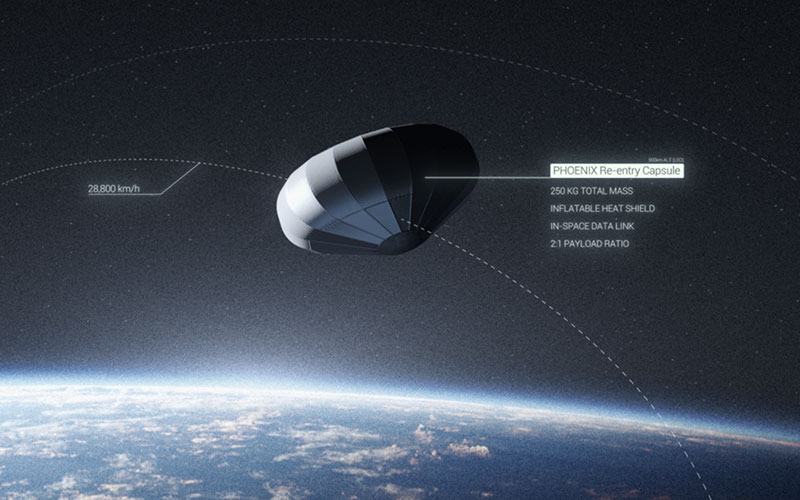ATMOS Phoenix Capsule Set for 2025 Test Flight After FAA Nod
ATMOS's Phoenix capsule, aimed at in-orbit life sciences, gets FAA green light for a 2025 test flight aboard SpaceX's mission.

Have you ever witnessed a shooting star blaze across the night sky and felt a moment of awe at the mysteries of the universe? Now, imagine a man-made marvel, a capsule, re-entering Earth's atmosphere with the same fiery spectacle, but this time, it's a herald of new beginnings in space logistics and research. This is the future ATMOS Space Cargo is crafting with its Phoenix re-entry capsule, a future that just got the green light from the U.S. Federal Aviation Administration (FAA) for a test flight aboard the SpaceX Bandwagon-3 rideshare mission in April 2025.
The Dawn of a New Era in Space Exploration
The approval marks a significant milestone for ATMOS, a German space logistics company that is not just looking to return materials from space but is also positioning its Phoenix capsule as a cutting-edge platform for in-orbit life sciences research. This initiative could transform how we approach scientific experiments in space, offering a new realm of possibilities for research that could benefit humanity in ways we are just beginning to understand.
Why does this matter now? We are on the cusp of a new age in space exploration. As commercial space ventures become more prevalent, the need for reliable, efficient logistics—both to and from Earth—becomes critical. The ATMOS Phoenix capsule represents a pivotal piece in this complex puzzle, promising to make the return journey from space not just safer but also more accessible to scientists around the globe.
Bridging the Cosmos and Earth
The technical ballet of launching, hosting life sciences experiments in orbit, and then safely returning the capsule to Earth is no small feat. The Phoenix is designed to withstand the harsh conditions of re-entry, protecting its precious cargo of research samples that could hold the key to groundbreaking discoveries in medicine, biology, and material science.
Imagine sending up experiments to study diseases in the unique microgravity environment of space, where cells behave differently than on Earth. The insights gleaned from these experiments could revolutionize our approach to combating illnesses or developing new materials with properties we can't yet replicate on the ground. The Phoenix capsule is more than just a vehicle; it's a bridge between the cosmos and our quest for knowledge.
A Symphony of Collaboration
This venture is not happening in isolation. The collaboration between ATMOS and SpaceX, facilitated by the FAA's approval, exemplifies the growing synergy between governmental regulators, commercial space companies, and research communities. Each player has a critical role in orchestrating the symphony of space exploration, ensuring not only the success of individual missions but also the safety and sustainability of space activities as a whole.
The implications of this successful partnership extend beyond the immediate missions. They lay the groundwork for future endeavors where space logistics serve as the backbone of an interplanetary economy, supporting not just scientific research but also the potential for manufacturing, resource extraction, and even human colonization of other worlds.
The Human Dimension
Behind every mission are the dreamers, engineers, scientists, and policymakers who make these leaps into the unknown possible. The approval of the Phoenix capsule's test flight is a testament to their dedication and vision. It's a moment of celebration for the ATMOS team, who have poured their skills and passions into designing a capsule that could redefine in-orbit research.
But the impact goes beyond those directly involved in the mission. For society, this represents a step forward in our continuous quest to understand the universe and our place within it. It's about pushing the boundaries of what's possible, not just for the sake of discovery but for the potential benefits to life on Earth. The life sciences experiments facilitated by the Phoenix could lead to medical breakthroughs or new technologies that improve our quality of life.
Looking to the Horizon
As we look forward to the launch in 2025, we're reminded of the boundless potential of human ingenuity and collaboration. The Phoenix capsule is more than just a piece of technology; it's a symbol of our collective aspiration to reach beyond our grasp, to explore the unknown, and to bring back knowledge that benefits us all.
In the grand tapestry of space exploration, each mission weaves a new thread, adding strength and richness to the story of our journey among the stars. The test flight of the Phoenix re-entry capsule is a beacon, illuminating the path toward a future where the barriers between Earth and space become ever more permeable.
As we stand on the brink of this new era, we're reminded that the final frontier is not just a place to conquer but a vast expanse of possibility that calls us to explore, to learn, and to dream. This is the promise of the Phoenix, as it prepares to rise, not just from the flames of re-entry, but from the collective ambitions of a species that looks to the stars and sees home.
This article was based on news originally published by European Spaceflight. Read the original article here.
#astronomy #science #space #europeanspaceflight #orbitnews